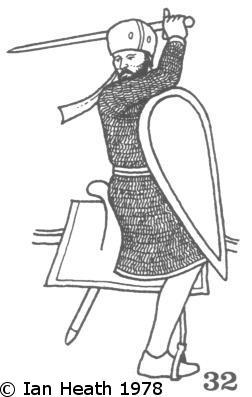Register a SNAP EBT card with Amazon

Join Amazon Prime - Watch Thousands of Movies & TV Shows Anytime - Start Free Trial Now
FATIMID CAVALRYMAN c. 1150
[based on a Fatimid Manuscript Fragment from Fustat, 12th Century.]
An extract from Armies and Enemies of the Crusades 1096-1291
by Ian Heath

32. FATIMID CAVALRYMAN c. 1150
The Saracen coat-of-mail seems to have gone under a variety of names, such as Dir’, Zard, Yelba, Lamat al-Harb,
Zardiyyat Sabila and Zardiyyat Musbala to mention but a few, these referring variously to shorter or longer corselets.
Some are described as ‘dragging’, while Sabila and Musbala mean ‘fountain-like’,
both of which tend to suggest that they might reach well below the knee, possibly even down to the ground.
This would be unusual, however, since generally Moslem armour remained considerably lighter than that of the Franks;
the Itinerarium Regis Ricardi, for instance, describing armoured as well as unarmoured Moslems at Arsouf in 1191,
says that they were ‘not weighed down with heavy armour like our knights’.
This is more true of the Turks than the Arabs, however, and even then there were exceptions
(see 58);
from the sources it is apparent that native Arab cavalry, as opposed to Bedouins or Turks, were usually armoured,
and Mayer concludes in his ‘Mamluk Costume’ that mail was the commonest form of Moslem armour.
This man appears to wear a turban rather than a helmet.
It has been argued that the turbans worn here are in fact no more than caps or coverings concealing helmets,
but since 31
wears an almost identical turban this seems unlikely (though still not impossible).
Undeniably helmets were sometimes concealed beneath turbans,
but it should also be noted that in the 13th century Jean Sire de Joinville wrote of Moslem turbans that they were capable of
‘warding the heavy blow of a sword’. The original ms. depicts this man’s turban as dull red with black markings.
They were most commonly white but could also be blue, black, brown or any other colour.
Though the original depicts him with only a sword a lance would normally be carried too,
but it is important to note that as he is an Arab he would not carry a bow. Usamah, a Syrian Arab,
does not record the bow in use by horsemen anywhere and he certainly never used one himself;
his battle anecdotes are almost exclusively of sword and lance thrusts,
and the Arabs clearly relied on their proficiency with these weapons rather than the bow, though some may also have employed javelins.
Cavalry lances generally went under the names Rumh, Mizraq and Hattiyya, apparently all very similar weapons probably differing only in length,
weight and blade shape; the heavy Rumh occurs most often. Another type, the Quntariya (cf. the Byzantine Kontaria),
was widely used by the Franks as well and was undoubtedly a long weapon, quite probably 12 feet.
The Berber Kabarhara, recorded by al-Tartusi, was also of considerable length, with a shaft of some 11½-l2½ feet and a (socketed?) blade of another 2-2½ feet.
Usamah records that c. 1120 the Arabs of Hamah adopted an even longer lance, lengthened ‘by attaching one lance to another’ and reaching a length of 18-20 dhira’ - 27-30 feet!
This must be an exaggeration, despite the fact that ordinary lances could certainly reach 15 feet.
However, it is interesting to note his description of such a compound lance in use, ‘trailing on the ground like a rope,
the warrior unable to raise it’, which certainly indicates that it was of unusual (not to say ridiculous!) length; one imagines the experiment was short-lived.
Lances were usually of cane or wood, Imad ad-Din writing of ‘brown lances’ at Hattin.
Next: 33. SUDANESE ARCHER in Armies and Enemies of the Crusades 1096-1291 by Ian Heath


